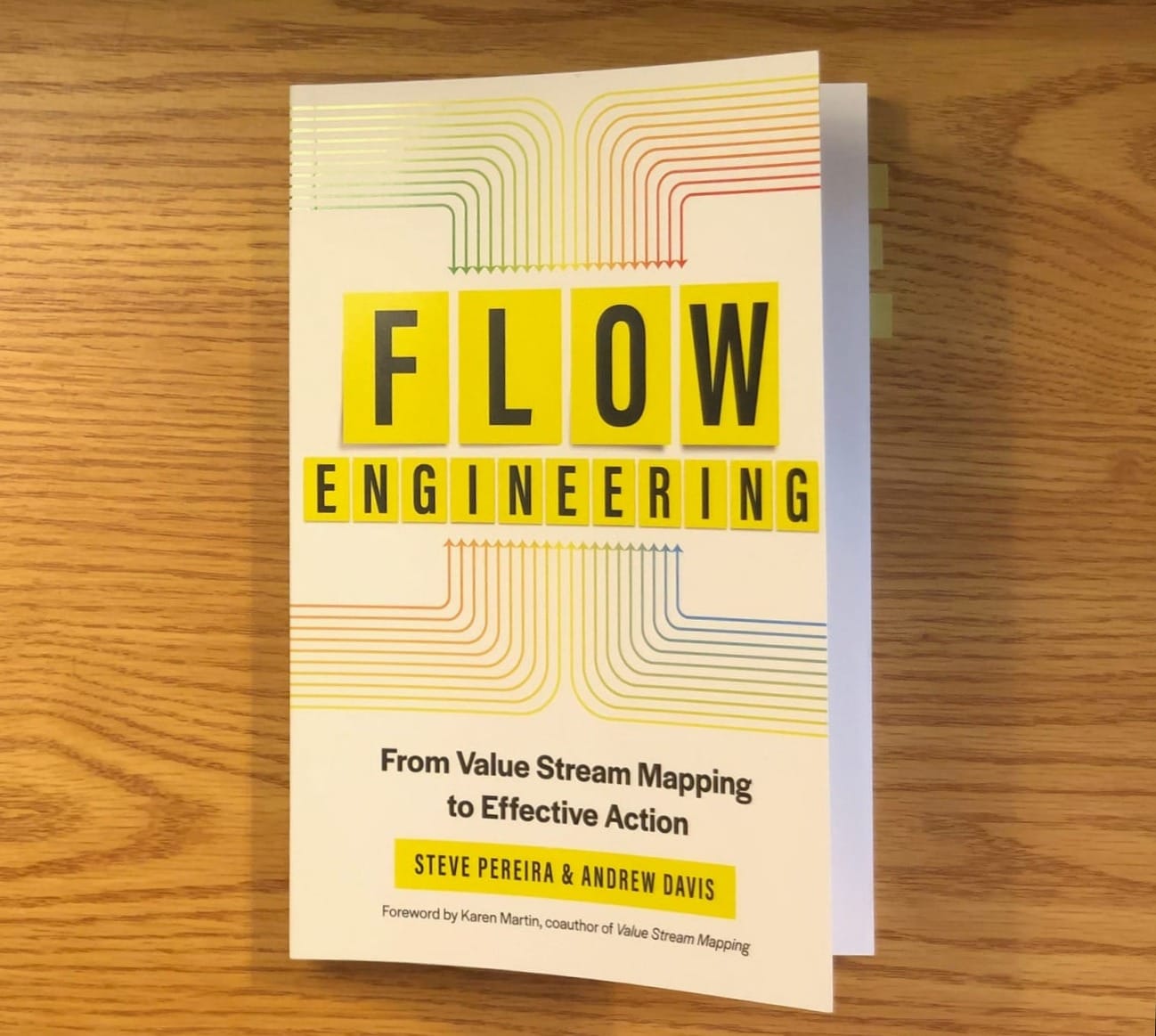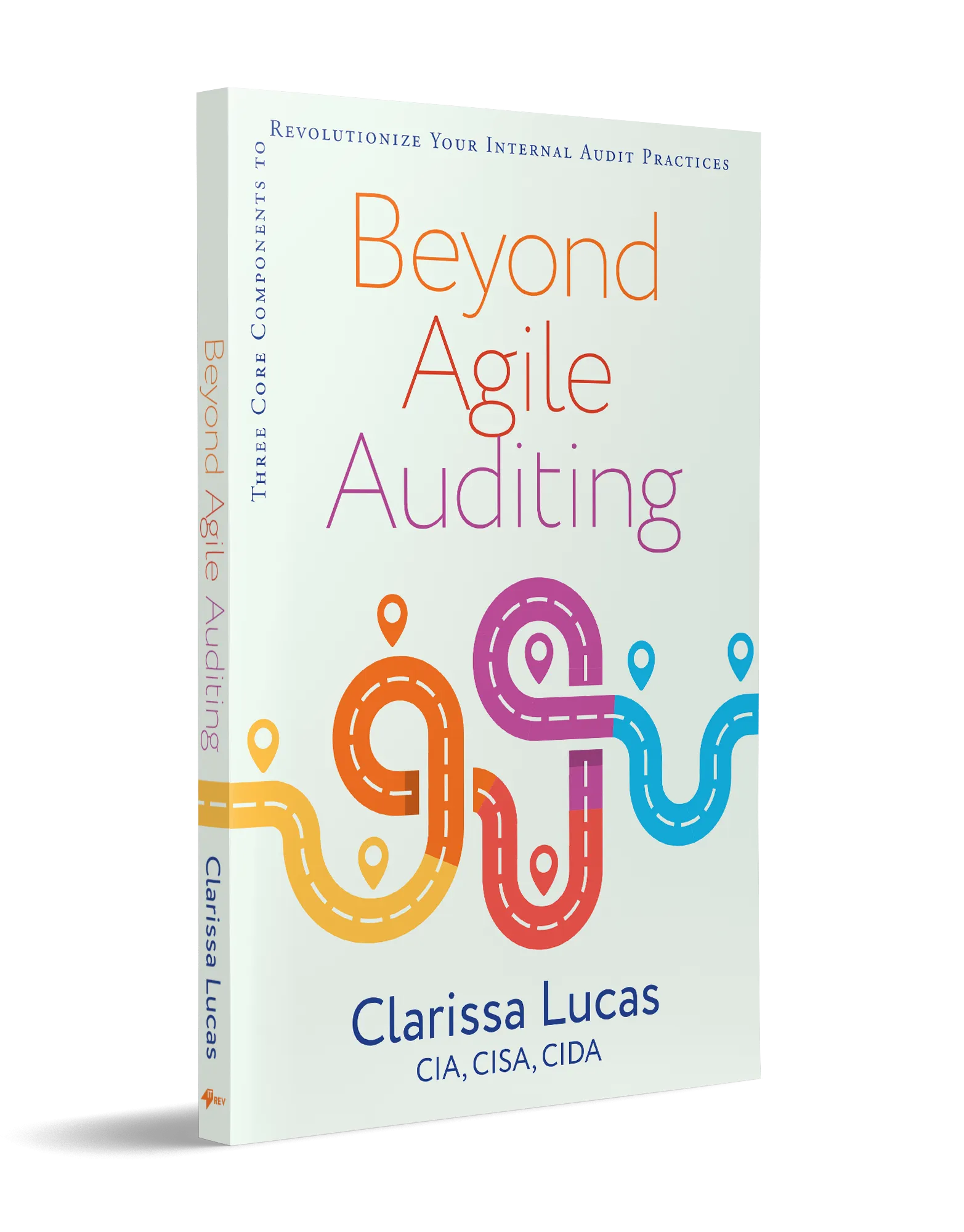Book Review: Flow Engineering - From Value Stream Mapping to Effective Action

I recently had the opportunity to read Flow Engineering - From Value Stream Mapping to Effective Action, and I was so impressed! If you've read it, please let me know your thoughts in the comments of this post. Meanwhile, here are my thoughts...
Initial Thoughts/Impressions
Getting a new book delivered is like Christmas morning. I love physical books, so it's always exciting when a new one arrives. This time was no different. The cover of Flow Engineering caught my eye right away: clean, yet colorful. The blocks surrounding the letters of the main title look like sticky notes - yes, like the sticky notes plastered all over my desk with inspirational quotes and reminders. That amazing theme carries over to the back cover as well.
Upon opening the book, I immediately noticed the high quality of the pages by their feel and look. Colors are used intentionally and effectively throughout the book. These seem like minor details, but to a book lover and self-proclaimed book connoisseur, the little details like this leave a big impression.
Kudos to authors Steve Pereira and Andrew Davis, and publisher IT Revolution Press. First impressions count, and this book certainly left a great first impression on me.
Organization
This 250+ page book is organized into fourteen chapters that are divided into three parts. The first part is dedicated to setting the stage for the rest of the book, the second part provides details on the mechanics of flow engineering, and the third part provides advice for the reader to set them up for success in their flow engineering journey. Each chapter concludes with a green box highlighting the chapter's key takeaways. I see future self referencing these often.
Content
Flow engineering is defined in the introduction as "a series of collaborative mapping exercises designed to connect the dots between an unclear current state and a clear path to a target state." [1] That definition right off the bat opens the door beyond traditional application of value stream mapping in technology. Immediately, this had me thinking of applying Flow Engineering to internal auditing.
The introduction also jumped right out to say that this book is for me:
"If you're looking to improve performance in a large-scale, complicated environment, this book is for you." [2]
The first four chapters set the scene by defining the problems with scale, explaining solutions to those challenges, and introducing flow engineering. The authors highlight challenges with scale, such as "distraction, disorientation, and disengagement" [3]. Other challenges with scale are increased distance from customers, decreased performance, increased waste, and difficulty collaborating. A core foundation for addressing these challenges builds upon Dominica DeGrandis's work of making invisible work visible. And flow engineering helps us do that.
As the concept of flow engineering is introduced, readers learn that there are five types of mapping exercise designed to address the challenges of scale and create a clear path to a better future state:
- Outcome map
- Current state value stream map
- Dependency map
- Future state value stream map
- Flow roadmap
The authors concisely explain that "[t]he outcome map defines the target..., the Current State Map and Dependency Map... inform the improvements to define a Future State Map..., which informs the Flow Roadmap... to define the path to the future state" [4].
The next five chapters equip readers with how to facilitate each mapping exercise. Each of these chapters explains the purpose of the map, how to facilitate the mapping exercise, and things to watch out for and optional variations of the exercise. The takeaways in these five chapters had me racing to finish the book so I could start experimenting with the maps right away.
The third part of the book sets readers up for a successful flow engineering journey by defining five key principles to guide the readers' efforts, providing insight on common challenges readers might face (and how to address them), and how to continue to refine and improve on the journey.
The chapter on flow engineering principles (chapter 10) had my highlighter hard at work again. One of the points the authors make is that if we focus on maximizing individual resource utilization (which is not an uncommon trend among among internal audit shops), we can end up reducing our flow (meaning it takes us longer to achieve our outcomes and deliver value to our clients). In a previous role, I was asked why this was the case, and I didn't have the answer... until now. The authors explain that increasing individual utilization can increase flow when there is little to no variability in how long each step in the process takes. In knowledge work, like interna auditing, we typically experience variation in how long a step takes. For example, sometimes it only takes a few hours to test a control. sometimes it takes days (or even weeks). With that variability "resources need slack capacity to be able to accommodate this variation. If everyone is maximally busy, there's little extra time or energy to address new challenges, and overall wait time tends to go way up" [5]. Thank you Steve and Andrew!
Another insight that really resonated with me came from chapter 11. "Many great plans are set in motion but are never accomplished" [6]. To avoid being another great plan left unaccomplished, the authors give readers advice, such as:
- Create a rhythm and maintain momentum by intentionally reviewing progress at regular intervals and assessing the approach based on progress (or lackthereof)
- Focus on simplicity. Instead of doing all the things, focus on doing the right things
- Create transparency through sharing progress and successes, as well as learnings from failures
Not only is this relevant to flow engineering, but itis also applicable to any plan. I'll be turning that advice into commitment statements and using them to maintain momentum while implementing plans going forward.
The authors also introduce the concept of governing constraints and enabling constraints. Governing constraints make it difficult to do the wrong thing, while enabling constraints make it easy to do the right thing. When we look at improving processes, we (especially as auditors) tend to think in terms of looking for and ensuring there are sufficient governing constraints in place. I wonder how shifting our approach to also considering whether there is an appropriate balance between governing and enabling constraints in place to appropriately manage risks within the organizations' risk appetite. The book continues by explaining that governing constraints work best when no uncertainty exists, and where uncertainty exists, enabling constraints are useful to encourage the right behaviors without becoming too restrictive.
These are just a few of the many items I highlighted in Part 3. There are so many other truly valuable insights to help organizations drive impactful change, regardless of whether flow engineering is used. These insights could have been a stand-alone book, but readers get this "bonus material" as part of the book.
Conclusion
Flow Engineering is packed with valuable insights and tangible takeaways that equip readers to start driving positive change in their organizations right away. Kudos to Steve Pereira and Andrew Davis!
I highly recommend this book to anyone who wants to drive positive change in their organization. Too many times I've experienced a lot of effort to drive positive improvements that produce underwhelming results. I'm guilty of being part of the problem. Value Stream Mapping (VSM) has been something I've wanted to apply to internal auditing for a couple of years now - so much so that I've even had conversations previously with Steve Pereira and other experts in the VSM community. Those conversations were SO insightful and helpful, yet I still wasn't getting it. This book inspires so many Ah-ha! moments for me. It filled in the gaps that I wasn't getting before. Now I feel equipped to try applying the concepts to internal auditing again. I can't wait to share my learnings with all of you when I do. I have so many insightful nuggets highlighted in this book, and I only anticipate that growing as I continue to revisit the book when I start applying the concepts in real life.
For those of you who have applied these (or similar) concepts to internal auditing, I'd love to hear about your experiences. Leave your insights in the comments below. And pick up your copy of Flow Engineering today!
[1] Pereira, S., & Davis, A. (2024). Flow Engineering: From Value Stream Mapping to Effective Action. Portland, OR: IT Revolution Press. p. xxi.
[2] Pereira, S., & Davis, A. (2024). Flow Engineering: From Value Stream Mapping to Effective Action. Portland, OR: IT Revolution Press. p. xviii.
[3] Pereira, S., & Davis, A. (2024). Flow Engineering: From Value Stream Mapping to Effective Action. Portland, OR: IT Revolution Press. p.5.
[4] Pereira, S., & Davis, A. (2024). Flow Engineering: From Value Stream Mapping to Effective Action. Portland, OR: IT Revolution Press. p.133.
[5] Pereira, S., & Davis, A. (2024). Flow Engineering: From Value Stream Mapping to Effective Action. Portland, OR: IT Revolution Press. p.174.
[6] Pereira, S., & Davis, A. (2024). Flow Engineering: From Value Stream Mapping to Effective Action. Portland, OR: IT Revolution Press. p.188.
Don't forget to get your copy of Beyond Agile Auditing: Three Core Components to Revolutionize Your Internal Audit Practices today. It's available in paperback, eBook, and audiobook versions. Order here.

Views or opinions expressed here are solely my own and do not express the views or opinions of my employer
